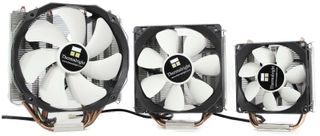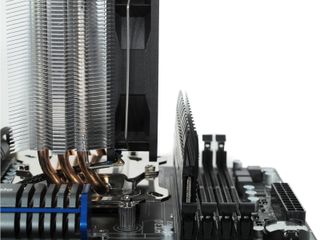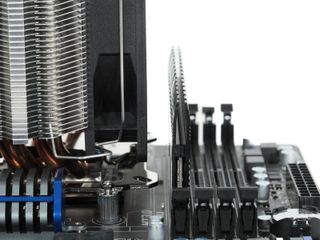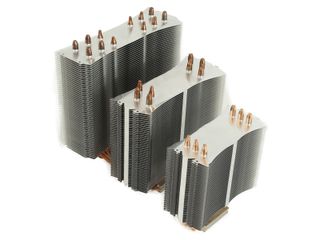Three Thermalright True Spirit Heat Sinks, Reviewed
Thermalright sent over all three models in its True Spirit heat sink family, complete with 92, 120, and 140 mm fans. We dropped each one onto an FX-8350 processor to gauge its cooling performance and acoustic output. Which one takes the value win?
Technical Specifications And Design

| Thermalright | True Spirit 140(BW) | True Spirit 120M(BW) | True Spirit 90M |
|---|---|---|---|
| Cooler Dimensions (HxWxD) | 170x155x53 mm (Without Fan) | 145x132x60 mm (Without Fan) | 125x102x56 mm (Without Fan) |
| (Note Offset Attachment of Base Plate and Fins) | (Note Offset Attachment of Base Plate and Fins) | ||
| 170x155x80 mm (With Fan and Decoupling) | 145x132x78 mm (With Fan and Decoupling) | 125102x75 mm (With Fan and Decoupling) | |
| Weight | 614/786 g (Without/With Included Fan) | 464/614 g (Without/With Included Fan) | 284/388 g (Without/With Included Fan) |
| Material | Aluminum, Copper | Aluminum, Copper | Aluminum, Copper |
| CPU Contact Surface | High-gloss Polished Base Plate | High-gloss Polished Base Plate | High-gloss Polished Base Plate |
| Number of Heatpipes | 6x6 mm | 4x6 mm | 3x6 mm |
| Fins | 50 | 48 | 43 |
| Fan | Thermalright TR-TY147 | Thermalright TR-12025-BW | Thermalright TR-9225-BW |
| 140x140x25 mm | 120x120x25 mm | 92x92x25 mm | |
| 900-1300 RPM | 600-1300 RPM | 600-2000 RPM | |
| 4-Pin PWM | 4-Pin PWM | 4-Pin PWM | |
| Cable Length | Approx. 310 mm | Approx. 310 mm | Approx. 310 mm |
| Interface Compatibility | Intel7751156136611552011AMDAM2(+)AM3(+)FM1FM2 | Intel7751156136611552011AMDAM2(+)AM3(+)FM1FM2 | Intel7751156136611552011AMDAM2(+)AM3(+)FM1FM2 |
| Warranty | 2 Years | 2 Years | 2 Years |
| Price | Approx. $50(Street Price) | Approx. $43(Street Price) | Approx. $28(Street Price) |
The two larger coolers have fans (the 140 mm TR-TY147 and the 120 mm TR-12025-BW) that are clearly optimized for quiet operation with a maximum RPM of 1300. The 90M comes with a smaller fan, the 92 mm TR-9225-BW, with a higher 2000 RPM ceiling necessitated by its more compact dimensions. All three fans come in a black-and-white color scheme that is standard for Thermalright’s budget lines.
On all three heat sinks, the cooling fins are curved up on one side and down on the other, though they differ in material thickness. The largest heat sink sports the thickest fins. Moreover, the True Spirit models with Ms in their product names (the 120M[BW] and 90M) are bent where they exit the base plate, resulting in an offset toward the back of the cooler.

This is the same design borrowed from Thermaltake's Macho family. Its purpose is to keep the cooler from blocking RAM slots on the motherboard, even with a fan installed. Only the True Spirit 140(BW) does not have bent heat pipes. Consequently, it pushes up against the RAM module in the slot closest to the CPU interface if it has a tall heat spreader. Memory can still be installed, but there's a good chance it'll get pushed aside by the cooler's fan.



Heat pipes are also arranged differently, depending on cooler. The True Spirit 90 M lines them up straight. They're offset pairs on the 120M(BW). And the 140M(BW) has parallel rows of three.

Thermalright’s two smaller coolers have retaining collars on all four sides to stabilize them and protect them from bent fins. The True Spirit 140(BW)’s fins are already so sturdy that it would take a lot of brute force to mess them up.

The heat pipes run through the base plate of all three heat sinks. Some light residue where they make their exit shows that they are soldered in place. The bottoms of the base plates are polished to a high-gloss finish.

Current page: Technical Specifications And Design
Prev Page Thermalright’s True Spirit Line Next Page Installing Thermalright's True Spirit FamilyStay on the Cutting Edge
Join the experts who read Tom's Hardware for the inside track on enthusiast PC tech news — and have for over 25 years. We'll send breaking news and in-depth reviews of CPUs, GPUs, AI, maker hardware and more straight to your inbox.
-
expl0itfinder I would love to see this compared against a wider selection of air coolers. For instance, the Cooler Master Hyper 212, or other fan favorites. Comparing it to 1 or 2 other brands does not give us a lot to look at.Reply -
Novuake A single other well known cooler for reference would have been great for easy context.Reply
Not all sites and reviews used Delta temps.
Nice review but kind of renders it moot for comparison out of the Silverstone and THermalright Scope. -
Someone Somewhere I think you got a bit lost on your graphs. At a guess, you meant to have one as distance from ambient, and one as absolute, or possibly there's idle readings.Reply
Also, please stick to the same units.
More comparisons would have been nice. -
SpadeM There are a few issues /omissions in the article, first being that the motherboard cap is only used on 939 sockets (i did an install for 970A-D3 AM3+ and it didn't require it) also the anchoring plate is flawed in my opinion because the screw holes that hold it in place aren't actually holes, but more live grooves on the outside of the plate and so the screws actually hold the plate in place with only half of their screw cap. And finally, for users that aren't experienced with multiple cpu heatsinks, tightening the final plate that locks the cooler in place ca very well damage your processor since there's no limiter in place.Reply
Other then that, those are some fantastic coolers, even though the thermal probe on FX-8350 under windows gives me flawed measurements in idle, under load it's quite good. -
iam2thecrowe 2000 rpm is noisy? i used to have a 6000rpm fan on my old athlon xp....... I think people these days are too picky about noise.Reply -
Someone Somewhere Reply11299459 said:2000 rpm is noisy? i used to have a 6000rpm fan on my old athlon xp....... I think people these days are too picky about noise.
Diameter has a lot to do with it - it's more to do with tip velocity than actual RPM. Your fan was likely about 40-50mm.
I've got 40mm fans that are near silent at 3K RPM. You can get 40mm fans that do 13K. -
ubercake Whether it's the motherboard or the heat sink manufacturers... We're still seeing 3rd-party CPU heat sinks and their fans blocking RAM slots for a decade. There's not much innovation going on here. I would tend to think the heat sink manufacturers need to accommodate the current motherboard designs. If they could solve that part of it in a full-size effective heat sink solution, innovation will have taken place. Until that time we'll keep seeing copper this; nickel-plated that; aluminum fins here; heat pipes there; one fan on this one; two fans on that.Reply
Same old stuff; different day. -
Myrkvidr @Someone Somwhere: Sorry, there's a copy&paste issue in the 2nd and 4th chart on page5: It should say "CPU temperature at 20°C ambient" while the 1st and 3rd chart are Delta temps.Reply
@SpadeM: Seems like I just did not RTFM close enough ;) But the measurement results were not affected by using or not using the plastic cap (I ran two separate measurement series). The anchoring plate is sitting very tight - I installed a lot of Thermalright heatsinks during the past couple of weeks. The contact pressure between the True Spirit heatsinks and the CPU is not excessively high, so it shouldn't cause any damage to the CPU.
@all: We just startet off with the new system for CPU cooler testing and had to start somewhere - there will be more results and coolers coming soon :)
